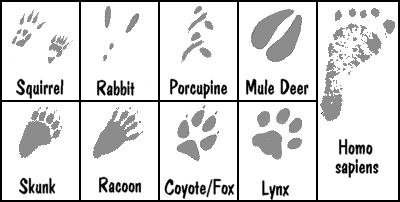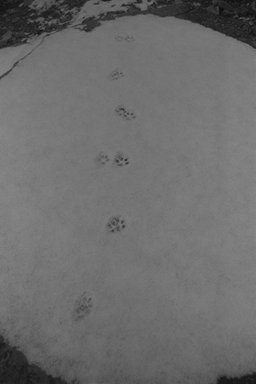|
Tracking the Inhabitants |
|---|
 Winter is an especially good time to seek out and study animal tracks within the park. A fresh layer of snow on the ground makes hunting out the tracks much easier and therefore much more enjoyable. You can frequently find good tracks just off of the Rim Trail which runs the entire length of the Hermit Road from Yavapai Point to Hermit's Rest. I have often seen the tracks of squirrels, cottontails, mule deer and coyote, and once I even discovered a set of lynx tracks
that came out of the Pinyon-Juniper forest and headed over the rim. Needless to say, I did not follow them. If you are seeking out animal tracks in the winter time and the ground is covered with snow, I suggest you stay on the other side of the Rim Trail and away from the rim. The rocks can be dangerous enough when they are dry and can be extremely dangerous when covered with snow or ice.
Winter is an especially good time to seek out and study animal tracks within the park. A fresh layer of snow on the ground makes hunting out the tracks much easier and therefore much more enjoyable. You can frequently find good tracks just off of the Rim Trail which runs the entire length of the Hermit Road from Yavapai Point to Hermit's Rest. I have often seen the tracks of squirrels, cottontails, mule deer and coyote, and once I even discovered a set of lynx tracks
that came out of the Pinyon-Juniper forest and headed over the rim. Needless to say, I did not follow them. If you are seeking out animal tracks in the winter time and the ground is covered with snow, I suggest you stay on the other side of the Rim Trail and away from the rim. The rocks can be dangerous enough when they are dry and can be extremely dangerous when covered with snow or ice.
Sometimes by following the tracks you can learn more about the animal that left them. I would suspect the lynx that left the tracks heading over the rim was returning home after an evening of hunting up on the rim. By following the tracks back into the forest you may learn whether the hunt was a successful one or not.
The lnyx is a creature of the night and most animals come out to forage for food during the early morning or evening hours. Some rodents will also come out in search of food at night and this is probably what the lynx was looking for and hoping to find. During the long winter nights, however, most of the rodents are normally huddled up together in a nice warm den, because staying close together helps to conserves their body heat when it is cold outside. This makes the lnyx search for something to eat considerably more difficult.
In the winter, when it is not hot during the daylight hours, animals can often be found foraging throughout the day. In the summertime it is uncommon to see any animals out during the heat of the day. The humans are the exception here. Tracks are much more difficult to find in the summertime but they are still there if you look closely. Much of the soil on the rim is very fine grained sand, almost like a powder, coating on the rocks or harder packed soil below. Because it is not very deep the impressions left in it by the passage of animals are very shallow and difficult to see. They can best be seen in the early morning or late afternoon hours when the shadows are deepest.
Another good time to search for animal tracks in the summertime is following any of the frequent afternoon thunderstorms. These torrenial, soaking rains will turn the soil to a slick clay-like muck that will hold the tracks of any animal passing through it very well. The soil will normally remain soft enough to hold tracks for many hours following a storm. If the storm is late enough in the day it may remain soft enough all night. Once the sun comes out again the tracks will be baked solid, until the next storm comes to wash them away.

|
Can you identify that animal that left this set of tracks?
I discovered these one morning while hiking along the Dripping Springs Trail and followed them along the trail for almost half a mile before they veered off and up into the cliffs. Click the image to find out which animal it was. |
|
|
|---|
|
|---|